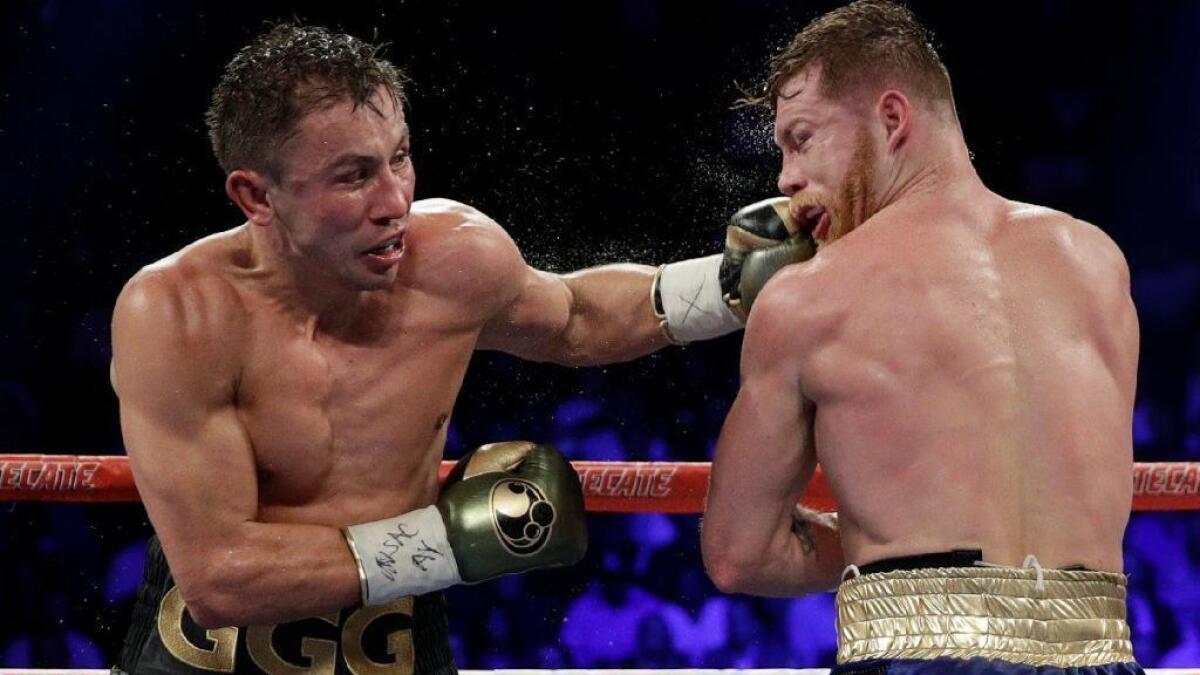Boxing regulations still lacking to protect fighters from head injuries

- Share via
Reporting from Las Vegas — When Gennady Golovkin and Canelo Alvarez step into the ring on Saturday night at T-Mobile Arena in Las Vegas, observers will be expecting two fighters to provide the kind of head-rattling finish fans crave.
However, boxing’s most dramatic moments can be the ones that involve the gravest physical damage. The absence of national regulation and monitoring of the unforgiving toll exacted on the human brain is a moral conundrum the sport continues to wrestle with.
“It’s one of the reasons boxing is such a guilty pleasure,” said Lou DiBella, a veteran New York fight promoter and former HBO executive. “Our greatest warriors are the guys you can most identify with having damage.”
DiBella said he’s conflicted by showcasing the ongoing performances authored by brave fighters while knowing the regulation of their health and safety leaves much to be desired.
He’s watched in sadness as his former middleweight champion Jermain Taylor has spiraled from knockout losses to multiple arrests.
After previously working with the late Sen. John McCain to craft the Muhammad Ali Boxing Reform Act and testifying to Congress about needed improvements years ago, the Harvard-educated DiBella said the sport requires help.
That could be provided, advocates say, by a national commission to institute consistent monitoring of fighters’ neurological exams and cognitive skills starting before their pro debuts, or a federal law requiring states to institute consistent medical tests in order to stage combat fight shows.
“It’s barbaric when you look at the state of health and safety regulation in boxing to think there are no standardized tests or regulations across all 50 states,” DiBella said. “In a number of states, all you need to fight is an eye test and an HIV test, and there’s guys fighting on club shows who’ve been knocked out 10, 15, 20 times who are getting approved.
“There’s no concussion protocols like the NFL has adopted,” in pulling a player off the field. “To stop the action and look at a fighter – at first I thought it was ridiculous – you’ve got to do that. It might save lives. But there’s no standard anything.”
Dr. Bennet Omalu, who first established Chronic Traumatic Encephalopathy (CTE) in examinations of the brains of late NFL players, said he’s come to believe “no one under 18 should box,” to avoid punishment to the developing brain.
California’s commission has pressed for national standards to address dehydration. New York has toughened its health reviews following the severe brain damage suffered by heavyweight Magomed Abdusalamov in a 2013 bout at Madison Square Garden, a case that resulted in the vegetative fighter’s family winning a $22 million settlement from the state.
“These issues are deep-seated. Commissions don’t talk to each other and share information [on fighters] as they should, and while we’ve tried to ramp up our medical protocols in New York, such as having ringside physicians assessing the fighters between all rounds, how others do it ranges from A to Z,” said Dr. Nitin K. Sethi, the chief medical officer of the New York State Athletic Commission.
In a 2015 fight in Fairfax, Va., Puerto Rico’s Prichard Colon sustained numerous punches to the back of the head, causing a brain bleed. He has been in a vegetative state since. Last year in Iowa, Rancho Cucamonga’s Daniel Franco returned to the ring less than three months after a knockout loss, was knocked down once, then knocked out for good in the eighth round and required life-saving brain surgery to emerge from a coma.
“If a guy’s knocked out, we need to consider if the length of suspension should be longer than 60 days … New York stops a lot of fights now, and I’ve made a conscience decision not to argue with them anymore because I’ve seen too much happen,” DiBella said. “We, as boxing fans, will say, ‘Oh, that guy quit like a dog,’ or, ‘That guy gave up.’ They’re in the ring, we’re not.
“If you see a guy realizing he has a head injury, or feeling weak or abnormal and that makes the guy quit, then God bless him, because it’s not about living to fight another day, it’s about living another day, and how you live all your other days.”
World Boxing Council President Mauricio Sulaiman is proud that his organization’s original $1 million donation to the UCLA neurological department in 1978 led to a $50 million government grant that has prompted “a revolution” of safeguards including shortening title fights from 15 to 12 rounds, staging day-before weigh-ins, improving gloves and encouraging the use of electrolytes.
Sulaiman says experts are close to suggesting, among other recommendations, a frozen helmet that boxers can wear between rounds to reduce brain swelling.
Those pressing for more safeguards confront the sport’s culture, including relentless work in sparring sessions.
“What happens in the gym is like Las Vegas – it stays in the gym,” Sulaiman said. “They keep registries of rounds sparred in Japan. And there should be limits on it.”
On Sept. 30 in Ontario, a ring war is expected between Oxnard’s former welterweight world champion Victor Ortiz and La Verne’s John Molina Jr. (30-7), who has three knockout losses, including in his 2014 fight of the year versus Lucas Matthysse.
Molina sounds a familiar refrain when asked if he’s paused to consider the risk of his work.
“The moment I think about that, it’s time to hang it up,” Molina said. “You can’t. In this sport, the reality and brutality of the sport is that if you’re not all in, you can get injured. I consider Victor a friend, but this is a business, the way I feed my family. Boxing changed my life and I have a beautiful lifestyle because of boxing. So I’ve accepted and digested the fact that me or Victor may not walk out of the ring on the 30th.
“I know my body. I’m still articulate. I can still carry a conversation. Yes, I feel the wear and tear of boxing, and this is going to sound idiotic, but I feel like this is my time now.”
Ortiz, once knocked out by Floyd Mayweather Jr., says he can’t deny the fighting spirit that has made him rich.
“I live for today. You can’t afford to,” consider brain damage, he said. “So many people tell you how to live. No. It’s my life. I was given some awesome tools, so I’m going to do what I want to do.”
Twitter: @latimespugmire
More to Read
Go beyond the scoreboard
Get the latest on L.A.'s teams in the daily Sports Report newsletter.
You may occasionally receive promotional content from the Los Angeles Times.











